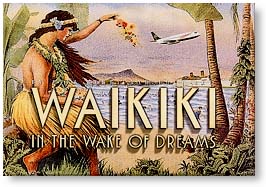Advertisement - Click to support our sponsors.


WAIKIKI: In the Wake of Dreams," the stunning new documentary by Hawaii filmmaker Edgy Lee and co-produced by Michael Foley, is as much about the people who live and come here as it is about the tarnished jewel of the Pacific.
In fading memories or
futuristic visions, Edgy Lee's
'Waikiki' sparklesBy Tim Ryan
Star-BulletinLee presided over a private showing of her film yesterday at the Hawaii Convention Center. The film will be screened for the public March 10 in the open-air venue of Kuhio Beach. (See information below.)

In the film, an elderly local man sums up Waikiki's enduring quality: "When I first came came to Waikiki, Diamond Head was old and I was young. Now I'm old but Diamond Head is young."
"Waikiki: In the Wake of Dreams
Interviews, photos and archival screen footage are used to capture the dream and reality of Waikiki. The dozens of people interviewed in "Waikiki: In the Wake of Dreams" agree that a thing of beauty lasts forever in one form or another. In spite of the urbanization process, Waikiki maintains its sparkle if you know how to look at it.

Singer Don Ho tells Lee he sometimes walks Waikiki Beach late at night pretending the hotels are gone and all that remains is what makes Waikiki a crescent stretch of beach that's filled people's fantasies for more than 100 years."Waikiki" begins simply with uncomplicated shots of local fishermen, underwater scenes of coral reefs and tropical fish, jumping dolphins, and people paddling outrigger canoes, perhaps the way early Polynesians arrived at Waikiki centuries ago.
Throughout the film, narrators, primarily "Uncle" Keola Beamer and the late Dr. George Kanahele, provide a substantial but easy to understand history of the place.
The mile-long beach was a favorite summer spot for Hawaiian royalty well before roads were built. The three streams that nourished the sands of Waikiki supplied food for locals who lived near where they emptied into the sea. (The streams long ago were diverted into the Ala Wai Canal.)
The more outsiders saw of Waikiki, the more they coveted it; and the more they wanted to change it to fit their needs and fatten their pocketbooks. So in came a dirt road, paved streets, hotels and businesses to take care, mostly, of visitors and ali'i, not so much the locals.
Lee treads delicately through one of the most tragic aspects of Waikiki's development, likely because film's sponsors included both state and Oahu visitors bureaus and Sheraton Hotels of Hawaii. In the early part of the last century the local government decided to dig the Ala Wai Canal, ostensibly to rid Waikiki of mosquitoes and the potential for insect-born disease. Though the film only alludes to it, the real reason was a lust for land in swampy Waikiki. Rice and taro farmers with their duck ponds owned much of the desirable land.

The farmers were taxed for the Ala Wai dredging. When unable to pay, they were forced to sell their property for pennies on the dollar. The government used the dredged soils to fill in the agricultural land, allowing more buildings in Waikiki.Lee profiles dozens of Hawaii musicians though the golden era of Hawaii, chronicles movie stars who vacationed in paradise, the films made here, the importance of air travel to Hawaii's tourism industry, and mega hotel and residential developers like Henry J. Kaiser.
The flavor of Waikiki comes through in grand style with Lee's interviews and histories of legendary beachboys, including the Kahanamoku brothers who she treats with the same respect as entertainers Ho, Benny Kalama, Kui Lee, Albert Apaka and politicians like Sen. Daniel Inouye. Curiously, no Hawaii governor was interviewed.
The viewer leaves this film knowing that Waikiki is lots more than a place where Tahitian dances are presented as Hawaiian, and plastic hula skirts as authentic.
There's an enduring history about Waikiki. The Diamond Head looming above the beach is the same one Kamehameha the Great viewed some 200 years ago. The waves breaking over the offshore reefs ridden by malihini from Malibu and Tokyo and Sao Paulo are the same ones where ali'i, Duke Kahanamoku, and writer Jack London slid on ocean swells.
"Waikiki: In the Wake of Dreams" ends where it began: in the water with a glimpse of Diamond Head without the concrete fortresses along the beach.
Close your eyes and pretend, like Ho, that there are no hotels but only sand, surf, three unfettered streams, and Hawaiians enjoying what nature created.
"Waikiki: In the Wake of Dreams" may make you a little sad but it also transports you to a place of fantasy.
Waikiki's first on-the-beach movie premiere stars the most famous stretch of sand in the world. Outdoor screening
Edgy Lee's film "Waikiki: In the Wake of Dreams" has its Hawaii premiere at 7:15 p.m. March 10.
The free outdoor showing on Kuhio Beach will be projected on a 22-by-30-foot screen during a full moon with Diamond Head as a backdrop.
The film will culminate a day of festivities beginning at 10 a.m. with the "Waikiki: In the Wake of Dreams" Hoolaule'a featuring Don Ho, daughter Hoku Ho, and the Royal Hawaiian Band.
The day will feature food vendors, lei sellers, coconut huskers, lauhala weavers and free entertainment.
At sunset, 100 torches will be lit along Kuhio Beach, followed by a performance by the Hos. The public screening is expected to attract several thousand people.
The Hawaii Visitors Convention Bureau, Oahu Visitors Bureau and Aloha Airlines are production sponsors of "Waikiki: In the Wake of Dreams," which tells the history of the one-square mile that has become one of the most famous travel destinations in the world.
In November, the HVCB sponsored the U.S. premiere of the film at the National Geographic Society in Washington, D.C.
Click for online
calendars and events.